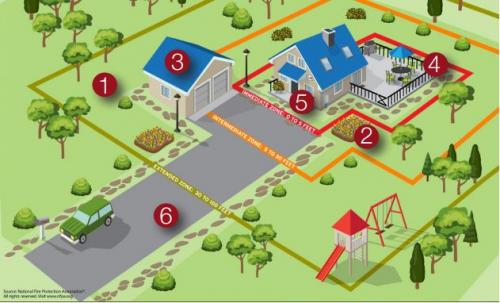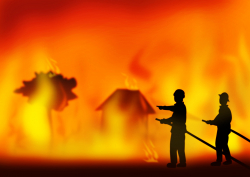Wildfire Safety
Preparing City Spaces
The City works with fire specialists, such as our partners at Tualatin Valley Fire & Rescue (TVFR) and Oregon Department of Forestry staff to assess and reduce wildfire risk in City spaces (more on this work here). The City owns over 600 acres of park land and is utilizing the West Linn Natural Hazards Mitigation Plan and Clackamas County Wildfire Protection Plan to prioritize areas to focus resources. Volunteers are always needed and appreciated: check out these regular volunteer opportunities or work with your neighborhood association to organize something in your area.
Preparing Your Home
Now is the best time to start preparing your home, fire officials agree that their greatest concern is your family's safety and the protection of your home. Small fires become large incidents when dry fuels are left near the home, in gutters or on roofs and become ignited by fire embers. Below are some resources and steps you can take to make your home safer this summer. We also encourage you to work together with your neighborhood association to make your whole neighborhood safer, many are Firewise certified (or in the process of becoming certified) and are a great resource. Finally, remember that even far-off wildfires can impact air quality and affect public health. Visit DEQ's Wildfire page and the Oregon Smoke Blog for more information about how to minimize smoke impacts.
Firewise How To Prepare Your Home For Wildfires
Take Steps Now to Prepare for Wildfires, Power Outages and Emergencies
Sign up for Public Alerts to receive emergency notifications about wildfires, including evacuation notices, and other emergencies.
Take steps NOW to protect yourself, family, household members, pets, livestock and other animals. Don't wait until the power is out!!
- Emergency Kit List from the American Red Cross, create a minimum 3 day emergency kit for evacuation and a minimum 2 week kit for your home
- Prepare for a power outage from PGE
- Check out TVFR's Ready, Set, Go resources to find practical steps to create a safety buffer around your home and property, make a plan, and be prepared to leave should you receive word to evacuate.
- Prepare for smoke impacts from even distant wildfires
________________________________________________________________________________
Firewise How To Prepare Your Home For Wildfires

1. Home Ignition Zones - Remove any flammable vegetation, wood or other materials surrounding your home, under decks and near foundations. Choosing fire-resistant building materials and construction techniques, along with periodic exterior maintenance increases the chances your home will survive a wildfire when exposed to embers and/or a surface fire.
2. Landscaping and Maintenance - To reduce ember ignitions and fire spread, trim branches that overhang the home, porch and deck, and prune branches of large trees up to 6 to 10 feet from the ground (depending on their height). Clean gutters of any debris.
3. Roofing and Vents - Class A fire-rated roofing products offer the best protection. Examples include: composite shingles, metal, concrete, and clay tiles.
4. Decks and Porches - Never store flammable materials underneath decks or porches. Remove dead vegetation and debris from under decks/porches and between deck board joints.
5. Siding and Windows - Embers can collect in small nooks and crannies and ignite combustible materials; radiant heat from flames can crack windows. Use fire-resistant siding such as brick, fiber-cement, plaster or stucco and dual-pane tempered glass windows.
6. Emergency Responder Access - Ensure your home and neighborhood has legible and clearly marked street names and numbers.
Be prepared. Develop, discuss, and practice an emergency plan with everyone in your home - make sure to include animals in your plan!
Watch the video below and learn more on preparing your home at the National Fire Protection Association (NFPA) website
_________________________________________________
Wildfire Resources

